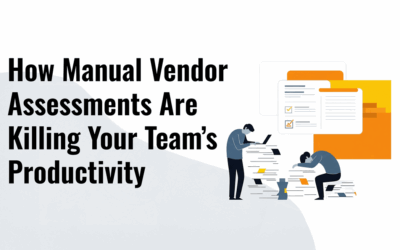This article delves into the anatomy of the National Public Data Breach, shedding light on the critical gaps in third-party oversight that led to this catastrophic event. You’ll gain insights into the legal and reputational fallout faced by organizations involved, and discover practical strategies to implement a robust third-party risk management framework. By examining the lessons learned from this incident, you’ll be better equipped to safeguard your organization’s sensitive information and maintain the trust of your stakeholders in an increasingly difficult digital environment.
Anatomy of the National Public Data Breach
The National Public Data breach, potentially affecting 2.9 billion individuals, stands as one of the largest data breaches in history. This unprecedented incident involved the theft of sensitive personal information, including full names, current and past addresses, Social Security numbers, dates of birth, and phone numbers. The stolen data, which covers people in the US, UK, and Canada, was offered for sale on the dark web by a hacker group known as USDoD.
Attack Vector and Methods Used
The breach originated from an attempted hacking of National Public Data’s systems in December 2023. The attackers exploited vulnerabilities in the company’s website and backend, gaining access to credentials posted in a file hosted on a publicly available website. This highlights critical flaws in National Public Data’s cybersecurity architecture, such as poor credential management and weak security processes.
Timeline of the Breach
The incident began in late 2023 and continued with two additional data exfiltration events in April and June 2024. On April 8, 2024, the stolen data was published on the dark web, with the hacker group USDoD offering the database for sale for $3.5 million. The breach remained undetected by National Public Data for a significant period, indicating a lack of visibility, detection, and tracking of data-related incidents within the organization.
Response and Disclosure Process
National Public Data confirmed the breach on August 16, 2024, stating that they were working with law enforcement to identify the hacker and determine the number of people affected. However, the company’s response has been criticized for its lack of transparency and timely notification to the victims. Many of those impacted remain unaware of their exposure due to the absence of direct communication from National Public Data.
The delayed disclosure and inadequate response have led to a class-action lawsuit against the company, claiming negligence in protecting customers’ sensitive data. The lawsuit seeks monetary relief, the purging of breached data, and the implementation of robust cybersecurity measures, including data encryption, segmentation, and annual cybersecurity framework evaluations.
The National Public Data breach underscores the profound risks posed by mass data aggregation and the glaring gaps in corporate responsibility when managing and communicating such incidents. It serves as a wake-up call for organizations to rigorously evaluate the cybersecurity practices of their partners and third-party vendors and highlights the need for stricter regulations and better enforcement to hold companies accountable for their data protection practices.
Identifying Critical Gaps in Third-Party Oversight
The National Public Data breach has exposed significant vulnerabilities in how organizations manage their third-party relationships. A closer examination reveals several critical gaps in third-party oversight that contributed to this catastrophic event.
One fundamental challenge is the lack of visibility into vendor practices. Many companies struggle to identify and gather the most relevant and valuable information about their third parties’ operations. Without a clear understanding of how vendors handle sensitive data, organizations are left vulnerable to potential breaches.
Inadequate contractual protections also contribute to third-party risk management failures. Vague language in contracts, such as using terms like “reasonable” or “adequate” to describe security measures, can lead to misinterpretations and inconsistent expectations between parties. As standards evolve over time, what was once considered sufficient may no longer be adequate, leaving organizations exposed to risk.
Insufficient ongoing monitoring is another critical gap in third-party oversight. While initial risk assessments and due diligence are essential, a vendor’s risk profile can change rapidly. Without continuous monitoring, organizations may miss emerging risks or changes in a vendor’s operations that could compromise sensitive information.
Organizations must take a proactive approach to third-party risk management to address these gaps. This includes:
- Establishing clear visibility into vendor practices through regular assessments and audits.
- Implementing strong contractual protections with specific security requirements and clear definitions of key terms.
- Conducting ongoing monitoring of vendor performance and compliance, with a focus on identifying new or emerging risks.
By closing these critical gaps in third-party oversight, organizations can better protect themselves from the devastating consequences of data breaches like the National Public Data incident. Investing in a robust third-party risk management program is essential for maintaining the trust of stakeholders and safeguarding sensitive information in an increasingly complex digital landscape.
Legal and Reputational Consequences
The legal and reputational fallout from a data breach can be devastating for organizations, with far-reaching consequences that extend well beyond the initial incident. As you navigate the complex landscape of third-party risk management, it is crucial to understand the potential fines, penalties, and long-term business implications associated with a data breach.
According to IBM’s Cost of Data Breach Report 2023, the average cost of a data breach reached an all-time high of USD 4.45 million in 2023, representing a 2.3% increase from the previous year. This staggering figure underscores the significant financial impact that organizations face in the aftermath of a breach. Furthermore, publicly traded companies suffered an average decline of 7.5% in their stock values after a data breach, coupled with a mean market cap loss of USD 5.40 billion.
Potential Fines and Penalties
One of the most immediate legal consequences of a data breach is the potential for substantial fines and penalties. Under data protection regulations like the General Data Protection Regulation (GDPR), organizations can face fines of up to 4% of their annual global turnover or €20 million, whichever is greater, for non-compliance. In May 2023, the Irish Data Protection Commission imposed a historic fine of €1.2 billion on Meta for GDPR violations, highlighting the severity of these penalties.
Moreover, organizations may be subject to additional fines and sanctions from regulatory bodies and industry standards. Failure to adhere to these requirements can result in the revocation of certifications, making it more challenging for businesses to operate effectively.
Impact on Brand Trust
Beyond the immediate financial repercussions, data breaches can profoundly impact brand trust and reputation. Studies have shown that up to a third of retail, finance, and healthcare customers will stop doing business with organizations that have experienced a breach. Furthermore, 85% of affected individuals will share their negative experiences with others, and 33.5% will express their frustration on social media.
This loss of consumer trust can have long-lasting effects on an organization’s ability to attract new customers, secure future investments, and retain top talent. Rebuilding trust after a breach can take years, if not decades, underscoring the importance of proactive third-party risk management.
Long-term Business Implications
The long-term business implications of a data breach can be even more significant than the immediate financial losses. Companies that experience a major data breach incident may underperform the NASDAQ by 8.6% after one year, with this gap widening to 11.9% after two years. This sustained underperformance can limit an organization’s ability to maintain its market position and compete effectively.
Additionally, data breaches can result in credit rating downgrades, impacting a company’s ability to secure financing and increasing borrowing costs. Moody’s, for example, announced in 2018 that it would evaluate companies’ cybersecurity practices when assigning credit ratings and subsequently reduced Equifax’s credit rating following their 2017 data breach.
As you develop your third-party risk management strategy, it is essential to consider these legal and reputational consequences. By implementing robust security measures, conducting thorough vendor due diligence, and maintaining transparent communication with stakeholders, you can mitigate the risk of a data breach and safeguard your organization’s long-term success.
Implementing Robust Third-Party Risk Management
The National Public Data breach underscores the critical importance of implementing a robust third-party risk management (TPRM) program to safeguard your organization against the devastating consequences of vendor-related incidents. A comprehensive TPRM framework should encompass risk assessment, technology solutions for vendor management, and incident response planning.
Risk Assessment Frameworks
Adopting a standardized risk assessment framework is a crucial first step in building an effective TPRM program. Frameworks such as the Shared Assessments TPRM Framework, NIST 800-161, and ISO 27036-2 provide a solid foundation for assessing and managing third-party risks.
These frameworks offer guidance on critical aspects of TPRM, including:
- Establishing clear visibility into vendor practices through regular assessments and audits.
- Implementing strong contractual protections with specific security requirements and clear definitions of key terms.
- Conducting ongoing monitoring of vendor performance and compliance, with a focus on identifying new or emerging risks.
Aligning your TPRM program with industry-standard frameworks can ensure a comprehensive and consistent approach to managing vendor risks.
Technology Solutions for Vendor Management
To effectively manage the complexities of modern vendor relationships, organizations must leverage technology solutions that streamline and automate key TPRM processes. Vendor management software (VMS) platforms offer a centralized system for onboarding, assessing, and monitoring third-party vendors.
Key features to look for in a VMS include:
- Automated workflows for vendor onboarding, risk assessments, and performance monitoring.
- Comprehensive risk management tools, including real-time continuous monitoring and incident management.
- Detailed analytics and reporting capabilities for data-driven decision-making.
- Integration with enterprise systems, such as ERP and CRM.
By implementing a robust VMS, organizations can gain real-time visibility into vendor risks, streamline compliance efforts, and proactively manage third-party relationships.
Incident Response and Business Continuity Planning
Despite best efforts to mitigate risks, vendor-related incidents can still occur. Organizations must develop comprehensive incident response and business continuity plans that address third-party risks to minimize the impact of such events.
Critical components of an effective incident response plan include:
- Clear roles and responsibilities for incident response team members.
- Documented procedures for identifying, containing, and responding to vendor-related incidents.
- Regular testing and simulations to ensure the effectiveness of incident response processes.
- Integration with broader business continuity management efforts to ensure rapid recovery and minimize disruption to operations.
By proactively planning for vendor-related incidents and integrating TPRM with broader business continuity efforts, organizations can build resilience and minimize the impact of third-party risks on their operations.
Implementing a robust TPRM program requires a multi-faceted approach that encompasses risk assessment frameworks, technology solutions, and incident response planning. By adopting industry-standard practices, leveraging advanced vendor management tools, and proactively preparing for potential incidents, organizations can effectively mitigate the risks posed by third-party relationships and safeguard their operations in an increasingly complex digital landscape.
Conclusion
The National Public Data breach is a stark reminder of the pressing need for strong third-party risk management in our interconnected digital world. By delving into the anatomy of this incident, we’ve uncovered critical gaps in vendor oversight and explored the far-reaching legal and reputational fallout that can stem from such breaches. This event highlights the importance of implementing robust risk assessment frameworks, leveraging cutting-edge technology solutions, and developing comprehensive incident response plans to safeguard sensitive information and maintain stakeholder trust.
As organizations navigate the complex landscape of third-party relationships, the lessons learned from this breach provide valuable insights to strengthen defenses against similar threats. By adopting a proactive approach to vendor risk management and staying vigilant in the face of evolving cyber threats, businesses can build resilience and protect their operations in an increasingly perilous digital environment.
To take your third-party risk management to the next level, contact ProcessBolt’s experts to discuss how the latest innovations in attack surface monitoring and AI can help you monitor your vendors effectively and prevent third-party breaches.




